Manuscript accepted on : 8 Nov 2020
Published online on: --
Plagiarism Check: Yes
Reviewed by: Dr. Muhammad, Naoshad
Second Review by: Dr. Kulvinder Kaur
Final Approval by: Dr. Saiful Irwan Zubairi![]()
Sunita Khatak* , Naman Wadhwa
, Naman Wadhwa and Pranay Jain
and Pranay Jain
Department of Biotechnology, University Institute of Engineering & Technology, Kurukshetra University, Kurukshetra-136119, Haryana, India
Corresponding Author E-mail: sunkhatak@rediffmail.com
DOI : http://dx.doi.org/10.13005/bbra/2881
ABSTRACT: Cissus quadrangularis belongs to family Vitaceae and is an edible medicinal plant found in India, Malaysia, Java, West Africa and Thailand. Mainly an osteogenic by nature, the plant is used for strengthening joints and bones, reducing pain and helps to re pair fractures so named as “Haddjod”. It has been reported in treatment of Bloody Diarrhea, skin disorders, ear ache, hemorrhoids, irregular menstruation and leucorrhoea. The plant is a potent antioxidant and a anti-inflammatory agent. The activity of aqueous stem extracts against Gram-negative bacteria: Escherichia coli (MTCC-5704), Pseudomonas aeruginosa(MTCC-2295),and two gram positive bacteria: Bacillus subtilis(MTCC-121) and Staphylococcus aureus (MTCC-3160) along with one cariogenic pathogen Streptococcus mutans (MTCC-497) was analyzed using agar well diffusion assay. Zinc nanoparticles and bimetallic Cu-Zn nanoparticles were synthesized using stem as plant part in contradiction to leaves which have been exploited by many nanotechnologists in nanoparticle synthesis as reducing and capping agent. Pathogenic microbes confirmed that the plant contains bioactive compounds which exhibited measurable antimicrobial activity against bacteria. Zinc nanoparticles have abundant scope in food as additives and packaging and are considered safe in food items. Synthesis of Zinc nanoparticles was further confirmed using UV visible spectroscopy and XRD analysis. While bimetallic Cu-Zn nanoparticles were confirmed by simple visual color change and UV visible spectroscopy. The bimetallic have been in more demand as compared to monometallic as they are better in magnetic, optical properties and this is the first report of bimetallic nanoparticle synthesis from Cissus stem.
KEYWORDS: Antimicrobial; Cissus Quadrangularis; Nanoparticles; Phytochemical; Zone of inhibition
Download this article as:| Copy the following to cite this article: Khatak S, Wadhwa N, Jain P. Monometallic Zinc and Bimetallic Cu-Zn Nanoparticles Synthesis Using Stem Extracts of Cissusquadrangularis (Haddjod) and Proneness as Alternative Antimicrobial Agents. Biosci Biotech Res Asia 2020;17(4). |
| Copy the following to cite this URL: Khatak S, Wadhwa N, Jain P. Monometallic Zinc and Bimetallic Cu-Zn Nanoparticles Synthesis Using Stem Extracts of Cissusquadrangularis (Haddjod) and Proneness as Alternative Antimicrobial Agents. Biosci Biotech Res Asia 2020;17(4). Available from: https://bit.ly/2V680Cp |
Introduction
Cissus quadrangularis belongs to family Vitaceae and have wide spread distribution in tropical parts of India. The plant is edible and is a succulent type of vine. It is found in Southeast Asia, Sri Lanka, Africa and Arabia. The plant is multipurpose and almost all plant parts are exploited for their pharmacological aspects. Stems have specific bone fracture healing properties and therefore named as “Haddjod” and Asthisamaharaka1. The roots and stems can be applied topically or can be prescribed as decoction, paste or in juice forms. Stem infusion have anti helmintic properties and fed to cattle for milk flow induction 2. Ash of plant is an alternative to baking powder while decoction with ginger and black pepper has been recommended in bodyache and muscular pain 3. The paste of stem is given in bowel infection related to indigestion and juice intake is relieving in menstrual disorders. The stem paste is also reported to be applied topically in snakebite, burns, wounds, and saddle sores of horses and camels 2. Literature is studded with reports of treatment of osteoarthritis, rheumatoid arthritis and osteoporosis.
Metallic nanoparticles biosynthesis has been reported earlier using leaf extracts from various plants such as Coffea Arabica, Azadirachta indica, and Agathosma betulina, Camellia sinensis, Hibiscuss abdariffa 4. Nanoparticle synthesis has been reported from leaves and stem of Cissus plant earlier for silver nanoparticles and depicted potent antimicrobial activity against bacteria 5. Antimicrobial aspects of zinc oxide nanoparticles have been further recommended for its usage in food preservation, a potent sanitizing agent for disinfecting and sterilizing food industry equipments and containers. Zinc oxide nanoparticles were synthesized using Parthenium hysterophorus leaf extracts and it revealed a quasi-spherical, radial, and cylindrical shape of nanoparticles with varied sizes, which were clustered together. The smaller size of nanoparticles has improved efficiency as antimicrobial agent and it covers the bacteria effectively causing better accumulation 6. Future prospects lie in synthesizing zinc oxide nanoparticles using living microorganisms and plants have wide range of applications in ceramics, electronics, rubber, paints, animal feed, cosmetics and pharmaceuticals industry. The zinc oxide nanoparticles are used in agriculture to provide nutrition to crop plants and it also provides resistance against pests 7. Moreover zinc oxide nanoparticle finds huge application in food industries as it is safe and has been reported in numerous marketable products 8. The most common nano-scale material present in food is silicon dioxide and titanium dioxide along with metallic silver. Silica/silicon dioxide acts as anti clumping agent to keep mixtures free flowing while titanium dioxide confer extra whiteness to white food items while nano-silver is used as disinfectant in clothing items. Fruits and vegetables are washed with nano-silver suspensions to make them more shiny while sunscreens are available with SPF factors. The nano indicators are available with the product itself to tell the quality of food which deteriorate with time. Soluble material contains these nanoparticles which can come in contact with vital systems. Although, the synthesis process is quite challenging as compared to the wet synthesis via sol gel methods, precipitation method and decomposition 9. Considering the vast potential of zinc oxide nanoparticles present investigation was carried out to synthesize ZnO and bimetallic Cu-Zn nanoparticles using stem of Cissus quadrangularis which has been reported in treatment of bloody diarrhea, skin disorders, earache, hemorrhoid, irregular menstruation and as a potent bone setter 10. Our present investigation is an insight into the synthesis of monometallic zinc and bimetallic Cu-Zn nanoparticles from Cissus stem to be a potent reducing and capping agent which is rare as leaves have been recommended to contribute for nanoparticles synthesis and here stem is used as reducing and capping agent.
Materials and Methods
Plant and Culture Collection
The stem of Cissus quadrangularis used in the present study for antimicrobial activity were procured from Tau Devi Lal Herbal Park, Khizrabad Highway, Yamunanagar, Haryana and identified from Botany Department of Kurukshetra University, Kurukshetra, Haryana, India. The various human pathogenic microorganisms were procured from Microbial Type Culture Collection (MTCC): Institute of Microbial Technology (IMTECH), Chandigarh; which included Gram- negative bacteria: Escherichia coli (MTCC-5704), Pseudomonas aeruginosa (MTCC -2295) and two gram positive bacteria: Bacillus subtilis (MTCC-121) and Staphylococcus aureus (MTCC- 3160) along with Staphylococcus mutans (MTCC-497). The Muller Hilton broth was made for preservation of the cultures. All the test tubes containing broths were kept at 4ºC in the refrigerator for further studies.
Preparation of Plant Stems Extract
The stems of Cissus quadrangularis were thoroughly washed with water then allowed for oven drying at 50-65 ºC till moisture fully evaporated and grounded into fine powder. The 5 gm of this powder was soaked in 50 ml of de-ionized water and heated at 70 ºC for 30 minutes. The extract was filtered with Whatman filter paper No.-1. The extract after filtration was stored at 4° C till further use and was used within a week for synthesis according to Shah and his coworkers (2015) with minor modification 11.
Preparation of Monometallic Zinc Nanoparticles Solution
Very simple and cost effective combustion method was employed for synthesis of Zinc oxide nanoparticles under laboratory conditions. Approximately 100 ml of aqueous solution of zinc nitrate (0.1 M) was prepared and mixed with leaf extract in a ratio of 1:2 (Plant Extract : Zinc nitrate solution). The 50 ml of zinc nitrate solution(dissolved) was added drop wise into 12.5 ml of plant extract and further the solution was incubated in water bath at 700 C for complete one hour according Ramesh et al., (2014) with minor modifications. The prepared solution was analyzed further for antimicrobial analysis 12.
Confirmation of Monometallic Zinc Nanoparticles
Synthesized ZnO nanoparticles were confirmed by visual observation i.e. by the color change of original solution to creamish colored solution and taking absorption maxima at the wavelength range of (300-600). The nanoparticles were extracted by heating the solution at 70° C using on stirrer heater until solution get converted to zinc oxide nanoparticle in deep yellow colored paste and then to powder. The nanoparticles were further kept in hot Muffle Furnance for two hours at 400° C for calcination 12 (Fig. 1).
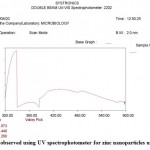 |
Figure 1: Peaks observed using UV spectrophotometer for zinc nanoparticles using Cissus stem. |
Preparation of Bimetallic Cu-Zn Nanoparticles Solution
Approximately 5 gram of copper sulphate pentahydrate (20 mM) and 6 gram of zinc nitrate (20 mM) were dissolved in 90 ml of de-ionized water and incubated at ambient temperature in water bath till solution became homogeneous. The 90 ml of this dissolved copper zinc solution was added drop wise into 10 ml of plant extract and the solution was incubated in water bath at 70° C for complete one hour. The prepared solution was analyzed further for antimicrobial analysis 13(Fig 2).
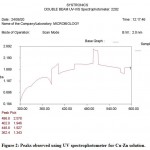 |
Figure 2: Peaks observed using UV spectrophotometer for Cu-Zn solution. |
Confirmation of Bimetallic Cu-Zn Nanoparticles
Synthesized Cu-Zn nanoparticles were confirmed by visual observation via color change of original bluish colored solution to dark green colored solution and taking absorption maxima at the wavelength range of (300-600)13 (Fig.3).
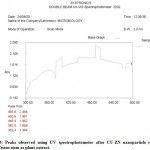 |
Figure 3: Peaks observed using UV spectrophotometer after CU-ZN nanoparticle synthesis using Cissus stem as plant extract |
Antimicrobial activity of plant extracts by Agar Well Diffusion Assay Method
The antimicrobial activities of plant extracts were evaluated by agar well diffusion assay 14. The microbial inoculums were inoculated aseptically spread uniformly on surface of pre solidified Mueller Hinton Agar (MHA) plates with the help of sterile glass spreader or sterile cotton swabs. A well of about 6.0 mm approximately diameter was aseptically punctured using a sterile cork borer. The cut agar disc was carefully removed by the use of sterile forceps. Plant extract was used as control. The Petri Plates were kept in laminar for 30 minutes for pre-diffusion to occur then Petri Plates were incubated overnight at 37° C for 24 hours. The antimicrobial spectrum of extract was determined in terms of zone sizes (diameters of inhibition zone) around each well. Zones were measured by high media zone scale.
Results and Discussion
The visual change in the color of the colloidal solution from greenish to light cream color confirmed the synthesis of zinc oxide nanoparticles which is expected to be due to coherent oscillation of electron gas at the surface of nanoparticles. The synthesis was further confirmed using UV–spectral analysis in range of (300-600) which resulted in an optical absorption band peak at 393 nm. However XRD analysis revealed the average particle size calculated using XRD pattern by applying Scherrer formula is about 31.94=32nm (Table-1). The X-ray diffraction (XRD) pattern of as synthesized ZnO nanoparticles obtained is as shown in (Figure 4) while bimetallic copper zinc nanoparticles were confirmed by visual color change of solution from green to bluish green colored solution.(Figure 5)
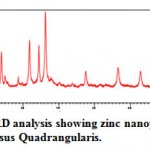 |
Figure 4: XRD analysis showing zinc nanoparticle peaks of Cissus Quadrangularis. |
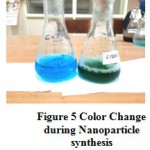 |
Figure 5: Color Change during Nanoparticle synthesis |
Table 1: The size of ZnO nanoparticles synthesized using Scherer formula deduced using XRD data.
| S. No. | Pos.[°2θ] | FWHM(°2θ) | D(nm) |
| 1. | 10.7623 | 0.6496 | 12.83 nm |
| 2. | 12.8315 | 0.4913 | 17.00 nm |
| 3. | 13.4951 | 0.1494 | 55.95 nm |
| 4. | 13.4951 | 0.1866 | 44.79 nm |
| 5. | 19.0937 | 0.4031 | 20.88 nm |
| 6. | 20.3492 | 0.1596 | 52.84 nm |
| 7. | 21.6475 | 0.2860 | 29.55 nm |
| 8. | 23.9531 | 0.3773 | 22.49 nm |
| 9. | 24.9780 | 0.5290 | 16.07 nm |
| 10. | 28.6392 | 0.2044 | 41.91 nm |
| 11. | 29.7127 | 0.4178 | 20.55 nm |
| 12. | 31.7874 | 0.3426 | 25.19 nm |
| 13. | 34.4190 | 0.3053 | 28.46 nm |
| 14. | 36.2564 | 0.3427 | 25.49 nm |
| 15. | 37.8857 | 1.1061 | 7.93 nm |
| 16. | 40.2291 | 0.4655 | 18.99 nm |
| 17. | 43.7759 | 0.1834 | 48.78 nm |
| 18. | 46.6622 | 0.0340 | 265.89 nm |
| 19. | 47.5456 | 0.4021 | 22.56 nm |
| 20. | 51.5453 | 0.2418 | 38.12 nm |
| 21. | 53.1446 | 0.3486 | 26.63 nm |
| 22. | 56.5671 | 0.5239 | 17.99 nm |
| 23. | 62.8280 | 0.5352 | 18.18 nm |
| 24. | 66.3616 | 0.3061 | 32.40 nm |
| 25. | 67.9170 | 0.6028 | 16.60 nm |
| 26. | 69.0369 | 0.6045 | 16.67 nm |
| 27. | 76.9626 | 0.7173 | 14.79 nm |
Antimicrobial Analysis
Any zone of size more than 2 mm is considered significant for antimicrobial activity. Our investigation for antimicrobial activity after zinc nanoparticle synthesis resulted in significant zones of inhibition against standard pathogens. The extracts were tested at four different concentrations of 25, 50, 100, and 150 µl as shown in Table-2. Although a lower concentration of 25 µl was tried against all bacterial pathogens. As the stem of Cissus has well known literature in bone fractures so antimicrobial concept against Streptococcus mutans a cariogenic pathogen was also tested. The zinc nanoparticles synthesized using Cissus stem resulted in a zone of diameter 13 mm at 50 µl followed by a zone of 18 mm at 100 µl and finally a zone of diameter 21 mm at a higher concentration of 150 µl against Streptococcus mutans. In comparison to zinc bimetallic copper-zinc nanoparticles resulted in zone of size 17 mm followed by 20 mm and 23 mm at three different concentrations of 50,100 and 150 µl respectively (Table-2).As Staphylococcus aureus have been observed to be major cause of many pathogenic disorders the present extracts were tested to consider the propensity of Cissus stem extracts. The extracts at 50 µl resulted in a zone of size 14 mm followed by 18 mm at 100 µl which in turn was followed by a zone of size 20mm at higher concentration of 150 µl concentration. The zone size goes on increasing in correlation to increased volume of extract considering zinc nanoparticles while bimetallic copper zinc nanoparticles resulted in zones of sizes 17 mm, 22 mm, 24 mm at three concentrations of 50,100 and 150 µl. The zone size showed a linear relationship with increasing concentration. Similar observation was reported by 14 and it revealed that zinc nanoparticles had more potential against gram positive bacteria Staphylococcus aureus and Bacillus subtilis. The research reported higher zones of inhibition against Escherichia coli, and Staphylococcus aureus using agar well diffusion assay. The investigation further revealed that nanoparticles are more potent against gram positive bacteria (Staphylococcus aureus) than gram negative (Escherichia coli.). Toxicity of zinc oxide nanoparticles was reported on Staphylococcus aureus and Escherichia coli and also on primary human immune cells 15. The 13 mm zinc oxide nanoparticles were potent enough to inhibit Escherichia coli at a concentration of 1 mM by loss of cell viability while immune cells were least affected at same concentration which inhibited gram positive and negative strains.
Table 2: Antimicrobial Activity of monometallic zinc oxide and bimetallic Cu-Zn nanoparticles synthesized using Cissus stem against selected pathogens.
| Pathogens | Volume of extract(µl) | Cissus (Zn-Np) | Cissus (Cu-Zn) |
| S. mutans | 25 | – | – |
| 50 | 13 | 17 | |
| 100 | 18 | 20 | |
| 150 | 21 | 23 | |
| S. aureus | 25 | – | – |
| 50 | 14 | 17 | |
| 100 | 18 | 22 | |
| 150 | 20 | 24 | |
| B.subtilis | 25 | – | – |
| 50 | 11 | 25 | |
| 100 | 18 | 29 | |
| 150 | 19 | 31 | |
| E.coli. | 25 | – | – |
| 50 | 18 | 23 | |
| 100 | 20 | 27 | |
| 150 | 22 | 29 | |
| P. aeruginosa | 25 | – | – |
| 50 | 14 | 23 | |
| 100 | 18 | 28 | |
| 150 | 23 | 30 |
Sarkar et al.,(2018) evaluated antimicrobial assay at four different concentrations of 25,50, 75, and 100 mg against Staphylococcus aureus and Escherichia coli using methanol as solvent system. Methanolic extracts were also found to be more potent against these bacteria in comparison to other solvents employed and were capable of inhibiting both strains significantly 16. The zones of inhibition were comparable to that of standard drugs. One observation was with an increase in concentration the inhibition capability also goes on increasing. Considering B. subtilis a gram positive bacteria the zone size were comparable to zones observed against previous two bacterial pathogens S. mutans and S. aureus giving zones of 11 mm, 18 mm and 19 mm (Figure 6) at three standard concentrations of 50,100 and 150 µl but the bimetallic extract synthesized using Cissus stem showed prominent activity against this bacteria specifically resulting in bigger zones of diameter 25 mm, 29 mm and 31 mm at same three concentrations of 50, 100 and 150 µl (Figure 7). The results can open new horizons to study bimetallic nanoparticles in inhibiting disease responsible due to Bacillus. Our results well corroborate with that of Tayal et al.,(2011) 17 who evaluated the comparative analysis of antimicrobial potential of zinc oxide nanoparticles against bacterial strains (mostly food borne pathogens) using qualitative and quantitative assays. Gram positive bacteria were more sensitive to zinc oxide nanoparticles than gram negative bacteria.
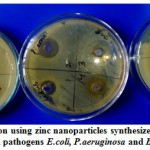 |
Figure 6: Zone of inhibition using zinc nanoparticles synthesized from Cissus stem against selected pathogens E.coli, P.aeruginosa and B.subtilis. |
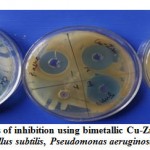 |
Figure 7: Prominent zones of inhibition using bimetallic Cu-Zn nanoparticles using stem extracts against Bacillus subtilis, Pseudomonas aeruginosa and Escherichia coli |
Most of the nanoparticles have been reported to be negligible in inhibiting gram negative Escherichia coli bacteria. But present results were remarkable as zones of inhibition of 18, 20 and 22 mm diameter were observed using zinc nanoparticles at three concentrations of 50,100 and 150 µl (Figure 6) while zones of greater size of 23, 27 and 29 mm were observed using bimetallic copper zinc nanoparticles during present investigation at three different concentrations of 50,100 and 150µl (Table-2)and(Figure-7).Antimicrobial assay of synthesized ZnONPs using fruit pulp of Aegles marmelos was tested against two fungal species, Fusarium solani and Aspergillus niger and three bacterial species representing both ‘Gram’ species namely Staphylococcus aureus, Pseudomonas aeruginosa and Escherichia coli. ZnO NPs exhibited very worthy antibacterial activity against Gram-positive bacteria Staphylococcus aureus with better inhibition zone contributed by 100 µg equivalent of ZnO suspension. In Gram-negative species, zone of inhibition was found less prominent compared to Gram positive. With Pseudomonas aeruginosa the effect was still prominent compared with Escherichia coli. It was noticed that E. coli showing (16 mm) 53.3% inhibition (at 100 µg of NPs), P. aeruginosa showing least inhibition of (5 mm) 16.6% (at 75 µg of NPs) and S. aureus is showing maximum inhibition of about (30 mm) 93.3% (at 100 µg of NPs) which is nearly equal to standard antibiotic used in research.
Merinal and Stella, (2012) reported three solvent extracts (diethyl ether, ethanol and aqueous) using stem of Cissus quadrangularis against E. coli, K. pneumoniae and S.aureus along with anti-fungal activity against A. flavis, C. albicans and Fusarium solani along with two standard antibiotics tetracycline and flucanozole. The zone of inhibition ranged from a minimum of (4 mm) in diethyl ether extracts against Staphylococcus aureus to a maximum of 10 mm using ethanolic extracts against Escherichia coli while antifungal activity ranged from 8 mm to 12 mm being lowest against Fusarium solani using ethanolic extracts while highest against A. flavis using diethyl ether extracts18. Kashikar and George (2003) reported antibacterial activity of Cissus quadrangularis against different gram negative and positive strains. Stem extracts were extracted using different solvent system such as petroleum ether, ethanol, methanol, ethyl acetate, acetone and aqueous extracts against B. subtilis , P. aeruginosa, S. aureus, S. typhi and S. pyogenes19. The methanolic and ethanolic extracts resulted in potent activity against bacterial pathogens contradictory to that petroleum ether, acetone ethyl acetate and aqueous extracts were failed to inhibit any bacteria. Escherichia coli did not respond to any of the extracts. MIC value of different solvent extracts against different pathogens ranged from a minimum of 0.465 mg/ml using acetone and methanol extracts against E. coli and S.aureus respectively to a maximum of 6.25 mg/ml using ethyl acetate fractions against S. typhi. Liu et al., (2009) reported the antimicrobial activity of zinc oxide nanoparticles of size 70 nm at different concentrations of 0, 3, 6, 12 m/mol against E. coli. A higher concentration of 12 m/mol inhibited E. coli completely and suggested the possible mechanism of zinc nanoparticles to distort and damage the bacterial cell membrane which in turn results in leakage of intracellular contents and eventually death of the cells 20.
In comparison to previous reports of nanoparticles the zone size observed against P. aeruginosa were also equivalent to that observed against other pathogens. A zone size of 14, 18 and 23 mm were observed using zinc nanoparticles at three concentrations of 50,100 and 150 µl (Fig. 6)while bimetallic copper-zinc nanoparticles were subsequently efficient in inhibiting the pathogens by producing zones of 23, 28 and 30 mm at three concentrations of 50,100 and 150 µl respectively (Fig 7). Evaluation of antimicrobial activity of Cissus quadrangularis against B. subtilis, E. coli, P. aeruginosa and S. aureus gave affirmative response; it can be assumed that the Zn nanoparticles have a higher antimicrobial activity even at the lower concentration in Haddjod. Shah et al(2017) reported Similar quite results stating that the ZnO nanoparticles produces a maximum zone of inhibition against Pseudomonas aeruginosa followed by Proteus mirabilis, Bacillus cereus, Escherichia coli and Staphylococcus aureus 11. The green synthesized ZnO nanoparticles are often used as an alternative to existing antimicrobial agents. Increased concentrations of zinc nanoparticles distort and damage the bacterial cell membrane which in turn results in leakage of intracellular contents and eventually leading to mortality of the cells. Still the mystery/mechanism behind the possible procedure is under investigation 21. The zinc nitrate ions can form intermediate complexes with OH groups of glucuronic acids which in turn are present in hydrolysable tannins, which subsequently undergoes oxidation to quinine forms with consequent reduction of zinc to ZnO nanoparticles, the ZnO nanocrystal are formed through nucleation and growth processes. Tannins were present in phytochemical analysis in both plant species so water soluble glucuronic acids are believed to play a major role in green reaction. The presence of alkaloids, carbohydrates, glycosides, Tannins, Phenolic compounds,, protein and amino acids, Gums and mucilage flavones, Saponins and flavonoids, steroids and sterols, ethyl acetate fraction was reported to consist of phytosterols, flavonoids and triterpenoids while hydroalcoholic fractions showed carbohydrates, tannins, amino acids and Vitamin C 22. The flavonoids and triterpenoids were found to be active constituents in plant stem which are key route for antimicrobial activities. The chloroform and acetone extracts resulted in zones from 12 mm to 14mm in comparison to aqueous extracts which gave zones of 11 to 13 mm.
Phytochemical analysis revealed the presence of sterols in all the fractions while methanolic and ethanolic extracts showed presence of phenols and flavonoids. In comparison acetone and aqueous extracts revealed alkaloids as major components 7. The antimicrobial analysis carried out using nanoparticles resulted in a maximum zone of 36 mm against Enterobacter aerogenes while moderate activity was reported against S.aureus and E. coli. The possible mechanism behind antimicrobial activity was estimated as electrostatic interaction between negatively charged cell membranes of micro organisms and positively charged nanoparticles. The zinc nanoparticles penetrate the membrane and in turn induce cell signaling pathways by dephosphorylation of peptide on tyrosine residues. ZnO nano- particles in the bacterial membrane causing a change in membrane integrity, interference in DNA replication, production of Reactive oxygen species etc., and exerts stress on membrane leads to depolarization of bacterial membrane and cellular content will ooze out 23,24. It was reported that ZnO NPs effect is more marked against Gram positive bacterial strains compared to Gram negative bacterial strains 25 Negative charged ZnO NPs interacted with Gram positive bacteria by electrostatic forces, hence causing inhibition 26. Various methods had been adopted for synthesis of ZnO NPs using green approach. Although Cissus stem has been used by Kalpana et al (2017) for zinc oxide nanoparticle synthesis and they reported pure spherical shaped 23-64 nm sized nanoparticles and further evaluated antibacterial, anti-helmintic, antioxidant and anti arthritic activities. Their study well corroborate with our present research in observing maximum zone of inhibition against E. coli a gram negative bacteria of 21 mm followed by S. aureus (15 mm and below 10 mm zones for Listeria, Salmonella and Klebsiella 27. So, Cissus stem extracts were capable of synthesizing zinc nanoparticles and break the persistent myth of nanoparticles to be more selective and specific in activity against gram positive strains in comparison to gram negative E. coli and P. aeruginosa. Our present research is one step ahead to synthesize bimetallic cu-zinc nanoparticles which were confirmed by visual change in color and further revealed zones of greater than 20mm size as shown in Fig. 6 and Fig. 7. So we propose that in future nanoparticles will be used as alternative to existing antimicrobial agents.
Conclusion
In conclusion, the present investigation devised a very economical and eco-friendly method to biosynthesize phytogenic monometallic ZnO and bimetallic Cu-Zn Nanoparticles using aqueous stem extracts of Cissus quadrangularis without use of toxic and hazardous chemicals. The characterization results revealed that biosynthesized ZnO NPs have an average size of 32 nm and exhibit good antimicrobial properties. Thus, biosynthesized ZnONPs could prove as an effective photo catalyst to be utilized for the degradation of harmful and toxic pollutants persisting in aquatic environment. One step Combustion synthesis of nanoparticles by using plants provides cost effectiveness and environmental protection. In this context, ZnO NPs were synthesized using Cissus stem which acts as both reducing and capping agents in synthesis part. XRD pattern show fine nanoparticles of size of minimum of 7.93 nm to 55.95 nm while larger size of 265.89 nm showed agglomerate formation of nanoparticles. ZnONPs showed excellent results with both gram positive and gram negative bacterial species, contradiction to previous reports which selectively inhibit gram positive strains in comparison to gram negative. Thus, the study demonstrates easy, effective way of using natural products as an energy fuels for the preparation of desired multifunctional ZnO nanoparticles with very good properties. The bimetallic synthesis of Cu-Zn nanoparticles in present investigation opens the doors to researchers to synthesize bimetallic nanoparticles in lieu of enhanced zones of inhibition and future potential to use as an alternative to antimicrobial agents.
Acknowledgment
We thank the Department of Biotechnology, University Institute of Engineering and Technology for the lab facilities provided for the completion of the project.
Conflict of Interest
The author declares no Conflict of Interest.
References
- Shirwaikar A., Khan S. and Malinib S. Antiosteoporotic effects of ethanol extracts of Cissus quadrangularis On ovariectomized rat. Journal of Ethnopharmacology. 2003; 89(2–3):245–250.
CrossRef - Basker S. and Kottamparambath M.Y. Antibacterial efficacy of Cissus quadrangularis from different provinces. Research in Pharmacy. 2013; 3(6).
- Balasubramaniana P, Jayalakshmib K, Vidhyab N, Prasada R, Khaleefathullah Sheriff A, Kathiravana G, Rajagopala K, Sripathi and Sureban M. Antiviral activity of ancient system of ayurvedic medicinal plant Cissus quadrangularis (Vitaceae). Journal of Basic and Clinical Pharmacy. 2010; 001(001):37-40.
- Salam H.A., Rajiv P., Kamraj M., JagadeesWaran , and Gunalan S. et al. Plants: Green route for nanoparticle synthesis. Int. Res. J. Biol. Sci. 2012; 1:85-90.
- Gopinath V, Priyadarshini S, Meera Priyadharsshini N, Pandian K, Velusamy P. Biogenic synthesis of antibacterial silver chloride nanoparticles using leaf extracts of Cissus quadrangularis Materials Letters. 2013; 91:224–227.
CrossRef - Datta A, Patra C, Bhardwaj H., Kaur S., Dimri N, and Khajuria R.C. Green synthesis of zinc oxide nanoparticles using Parthenium hysterophorus leaf extracts and evaluation of their antimicrobial properties. J of Biotechnology and biomaterials. 2012.
- Sindhura, K. Sri, Prasad, T.N.V.K.V. and Hussain, O.M. Synthesis and characterization of phytogenic zinc nanoparticles and their antimicrobial activity. Proceeding of the international conf. on Advanced nanomaterial and emerging engineering tech.(ICANMEET-2013).Sathybama Univ., Chennai, India in association with DRDO,NewDelhi,India(24th-26thJuly,2013).
- Tayal A.A. ,El-Tras F., Moussa S., El-Baz A.F., Mahrous H. ,et al.Antibacterial action of zinc oxide nanoparticles against food borne pathogens. J Food Safety. 2011; 31:211-218.
CrossRef - Suntako, R. Effects of zinc oxide nanoparticle synthesized by precipitationmethod on mechanical and morphological properties of the CR foam. Mater. Sci. 2015; Vol 38(4).pp 1033-1038.
CrossRef - Murthy C., Vanitha K.N., Swamy M.M. and Ravishankar G.A. Antioxidant and antimicrobial activity of Cissus quadrangularis. Med. Food. 2003; 6:99.
CrossRef - Shah R.K., Boruah F. and Parween N..Synthesis, characterization of Zno nanoparticles using leaf extracts of Camellia chinensis and evaluation of their antimicrobial efficacy. J. Curr. Microbiol. Appl. Sci. 2015; 4(8), 444-450
- Ramesh P., Rajendran A., and Meenakshisundram M. Green synthesis of zinc oxide nanoparticle susing flower extract of cassia auriculata. of nanoscience and nanotechnology. 2014; 2(1), 41-45.
- Minal SP, Prakash S. Cu-Zn and Ag-Cu bimetallic nanoparticles as larvicide to control malaria parasite vector: a comparative analysis. In 2016 IEEE Region 10 Humanitarian Technology Conference (R10-HTC) 2016 Dec 21 (pp. 1-6).IEEE.
CrossRef - Perez, M. Pauli and P. Bazerque, “An antibiotic assay by agar well diffusion method”, ActaBiologiaet Medicine Experimentalia. 1990; 15:113-115.
- Getie S., Belay A., Reddy A.R. and Belay Z. Synthesis and characterization of zinc oxide nanoparticles for antibacterial applications. Journal of Nanomedicines and nanotechnology. 2017; S8:004 doi:10.4172/2157-7439.
CrossRef - Reddy K.M., Feris K, Bell J, Wingett DG , Hanley C et al. Selective toxicity of zinc oxide nanoparticles to prokaryotic and eukaryotic systems. Phys. Lett 2007.
CrossRef - Sarkar BK ,Kumar R, Kumar V, Reeta , Shasipal C., Murti Krishna, Verma SC, Singh R., and Ramaiah M. Antimicrobial and phytochemical evaluation of Cissus quadrangularis Int. J. OF Ayurveda and Pharma Research. 2018; 6(7):24-28.
- Tayal A.A., El-Tras W.F., Moussa S., El-Baz A.F, Mahrous H. et al. Antibacterial action of zinc oxide nanoparticles against food borne pathogens. J Food Safety. 2011;31:211- 218.
CrossRef - Merinal S and Viji S. In vitro screening of antimicrobial potential of Cissus quadrangularis Asian J. of Plant Science and Research. 2012; 2(1):58-62.
- Kashikar N.D, and George I .Antibacterial activity of Cissus quadrangularis Indian J of Pharma Sci. 2003; 68(2).244-247.
- Liu, L. He, A. Mustapha, H. Li, Hu ZQ and M. Lin, “Antibacterial activities of zinc oxide nanoparticles against Escherichia coli O157:H7”. Journal of Applied Microbiology. 2009;107(4):1193-1201.
CrossRef - Teware K, Singh P, and Mehta R. Phytochemical extraction and analysis of medicinally important plant Cissus quadrangularis(Haddjod). Biomedical and Pharmacology J. 2011; 4(1):175-179.
CrossRef - Dobrucka R. and Długaszewska J. Biosynthesis and antibacterial activity of ZnO nanoparticles using Trifolium pratense flower extract. Saudi J. Biol. Sci. 2016, 23, 517–523.
CrossRef - Díaz-Visurraga J., Gutiérrez C., Von Plessing C. and Garcí A. Metal nanostructures as antibacterial agents, science and technology against microbial pathogens: research, development and evaluation. Formatex, Badajoz. 2011, pp. 210–218
- Oves. Antimicrobial activity of metal oxide nanoparticles against Gram-positive and Gram-negative bacteria: a comparative study. Int. J. Nanomed. 2012, 7, 6003.
CrossRef - Raghupathi K.R., Koodali R.T. and Manna A.C. Size-dependent bacterial growth inhibition and mechanism of antibacterial activity of zinc oxide nanoparticles. Langmuir. 2011, 27, 4020–4028.
CrossRef - Kalpana V. N., Patra R. P. and Rajeshwari Devi V. Green synthesis of zinc oxide nanoparticles using fresh stem of Cissus quadrangularis extract and its various in vitro studies .Asian J. of chemistry. 2017, 29(6).1323-1327.
CrossRef

This work is licensed under a Creative Commons Attribution 4.0 International License.





